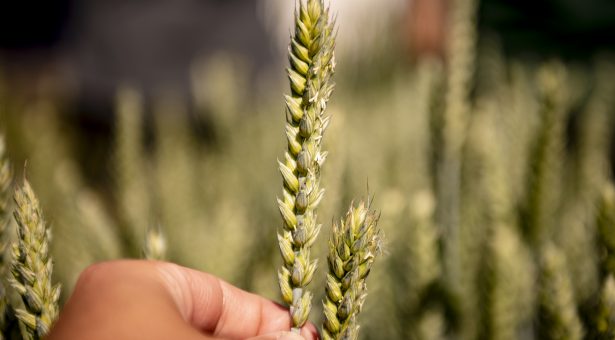Wheat

Wheat is the most widely cultivated crop in the world: Global Trends in Wheat Production, Consumption and Trade. Wheat genetic research is an important tool in addressing the need to feed an increasing population under increasing land pressure and global warming.
There is a diverse range of wheat research currently undergoing experimental trials at Church Farm. For example, there are experiments aimed at improvement of wheat through understanding the genetics of many traits including yield, plant height, grain size, disease resistance, root architecture and the relationship of the root with soil microbes.
Understanding Yield in wheat
Dr Simon Griffiths’ group studies height and flowering time in bread wheat and the genes that control the interaction between these traits to influence yield.
Large scale screening of wheat lines is carried out to identify traits of interest. Traits such as yield, stem strength and flowering time are measured in real time under agricultural conditions. Specialised techniques are used to identify the genetic variation and tools are developed to inform breeders of traits of interest alongside provision of pre-breeding germplasm that can be used to produce new wheat varieties. Extensive use is made of old varieties to capture genetic variation that is lost to modern bread wheat but through research carried out at the JIC can now be used.
Professor Cristobal Uauy’s group combines genetics and genomics approaches to identify genes involved in wheat productivity and grain quality and use this knowledge to improve wheat varieties for industry and the consumer.
A wheat line has been developed that produces 20% larger grains. Field studies are underway to understand the relationship between increased grain size, yield and resource availability.
This year a wheat that has been genetically edited is being trialled. Gene editing refers to editing the genes already in the plant, not introducing genes from another species. In this case the genetic code for a gene partly responsible for the shape and size of the wheat glumes (husks) and floral organs has been altered which leads to longer glumes, which in turn results in larger grain. This trial is looking to see if this translates into higher yield. The information needed for editing the gene is found from looking at wheat varieties and wheat sub species that have longer glumes.
Improving nutritional quality of wheat
The Uauy and Balk groups are growing field trials of wheat with increased iron and zinc levels. In the UK, all wheat flour is fortified with iron.
By changing the expression pattern of a wheat gene involved in iron distribution, the researchers have increased the iron content in white flour to a level that exceeds the minimum requirement.In principle, iron could then be dropped from the ingredient list if this wheat variety is used.
They have also made a genetic change to increase zinc, another important mineral nutrient. The field trials are run over 3 years, to see if the iron and zinc levels match those measured in greenhouse-grown plants, and to check the stability of the mineral levels in relation to the weather (wet or dry summers and other influences).
The wheat is classified as GM, because of the methods used for making this small change to the DNA, but the wheat flour does not contain novel proteins or other molecules that don’t already occur in our food.
Drought tolerance
Dr Philippa Borrill’s group is investigating how altering the rate of senescence (ageing) of a wheat plant affects yield, nutrient content and stress tolerance. Field studies are under way to test whether genes that accelerate or delay senescence can improve tolerance to drought stress.
James Simmons (Uauy Group) is trialling wheat varieties with different root architecture to test whether in drought conditions, longer and straighter roots have a greater drought tolerance.
Soil Health
Dr Maria Hernandez-Soriano in Professor Tony Miller’s group is researching the rhizosphere (the soil adjacent to the plant roots). Some varieties of wheat can absorb nutrients better than other varieties because of their relationship with microbes in the soil. Historical wheat cultivars are being grown to identify those with useful root traits. Maria is leading a project called WISH-ROOTS; Wheat roots in soil health.
